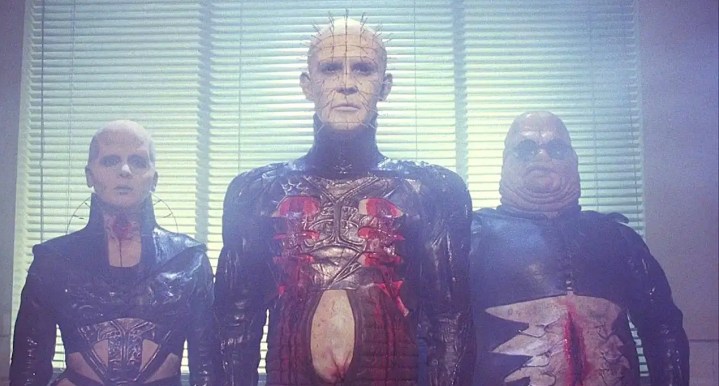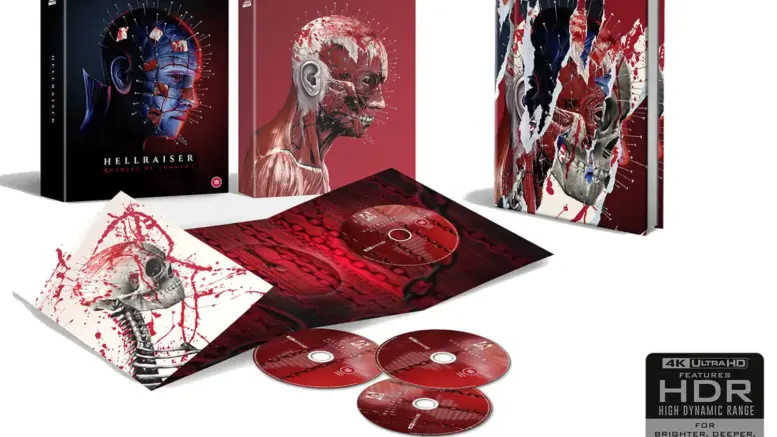Written and Directed by: Clive Barker
Hellraiser as a movie is 36 years old. Written and directed by Clive Barker, adapted from his own novella The Hellbound Heart in 1987, like a lot of wildly inventive horror movies in the Eighties and Nineties, it spawned a whole raft of sequels. So far, we’re up to ten Hellraiser movies, including a modern, vastly different retelling of the original.
The first four movies in the chain – often regarded by hardcore Barkerphiles as “the best ones” – have just been re-released as the positively sumptuous Quartet of Torment, in new 4k versions, with re-edited sound, extras, documentaries, and all the fun add-ons the 21st century demands.
But if you’re going to pump up the visuals, polish up the audio and re-release a sequence of Eighties and Nineties horror movies, you’re going to face one big question: apart from those who were there the first time round, who’ll dig the nostalgia of watching those movies again, is it worth it?
Is it worth the effort for a bunch of Eighties and Nineties horror movies?
When it comes to the original Hellraiser, you ask that question and you’ll get an unequivocal Hell yes! for your trouble.
The thing people forget about Eighties and Nineties horror movies that spawned sequels with arguably ever-diminishing returns, is that the originals were usually something reeeeeally special.
The Nightmare on Elm Street movies, which eventually descended into high-camp killfests, started as a treatise on mob justice, the failings of an official judicial system, and what would happen if the terror we all feel in dreams was actually fatal.
Halloween began as an exploration of senseless, inexplicable murder and psychosis, and the impact it can have on a family, a town, and a national psyche.
Even Friday the 13th was originally a masterpiece in the trauma of loss, grief and obsession after the death of a child, and the irrational ways in which it can seek release.
The Hellraiser Difference
Hellraiser though raised the bar in a horror market that was, by the second half of the Eighties, a little saturated with explicable, essentially human horrors. With its introduction of the Cenobites – a small gang of grotesques that could deliver both staggeringly outre visuals and a sense of inevitability that went far beyond serial killer grimness. The Cenobites embodied the Hell in the title. They were implacable, and cold, and very, very different to your common-or-garden multi-slasher.

What you get, on a rewatch of the original Hellraiser in 2023 is a reminder of actually how little screen time they have, and consequently, how much of an impact they make of it.
The majority of Hellraiser is something out of the Tennessee Williams playbook. Two brothers, one woman, who’s married to the dull, obedient nice guy, while feeling desperately sexual and alive and awakened by the other, bad boy brother, Frank (Sean Chapman).
So far, so “I do declare it’s hot, I need a mint julep.”
But wound through that almost common premise is the idea that Frank, whose extreme hedonism is a large part of what makes Claire Higgins’ Julia fall for him in the first place, has found adventures he can’t cope with.
He’s bought something called a LeMarchand puzzle box, which opens doors between dimensions – and in his particular case, it’s brought him into contact with the Cenobites. They have, as is their wont, “killed” him in terms of having a body, though his soul remains their plaything forever.
But when Julia and her feckless husband Larry (Andrew Robinson) move into the house where Frank was killed, and Larry bleeds on the floor, it sets in motion a storyline that feels like it should have precedents in classic gothic horror, but doesn’t, exactly. Frank can come back from the dead, but he needs more blood to rebuild himself a body – and he enlists Julia to go bar-cruising to bring hapless men home on the promise of sex (ah, the world before the likes of Tinder), where she can murder them with a claw hammer and Frank can do unspeakable things to their bodies to rebuild his own.
And it’s worth remembering that the reason Julia turns murderer is that she wants to resume her torrid affair with Frank, but can’t until he’s…erm…significantly better endowed with bloodflow than he is for most of the movie.
The Princess Who Defeats The Demons
Into all this is also thrown Ashley Laurence as Kirsty Cotton, Larry’s daughter from a previous marriage. Like all princesses in fairy tales, she’s not keen on her stepmother, being the only person who can see beyond Julia’s apparent frigidity to the psychological nightmare underneath.
Laurence, bless her, was a fairly standard virgin-in-an-Eighties-horror-movie back when Hellraiser was originally released. But here’s where the revamped, remastered version in the Quarter of Horror really starts to make its mark.
Because, back in the Eighties, the relationship dynamic between the three adults that came across the screen was OK, but you were waiting for the Cenobites to turn up and for things to get interesting.
Watching the souped-up version in 2023, the dynamics between those three adults are absolutely enough to make you forget you’re watching a horror movie. The tweaks here and there give you a clearer sense of Julia’s ste-by-step descent into pain, and pleasure, and pain as pleasure.
Claire Higgins is a masterclass in repression released through submission and a degree of violence. Sean Chapman as Frank practically sizzles with every step he takes, and the new print helps him feel like heyday-Brando with a sadism kink. And you can practically smell the frustrated sexual desperation coming off Andrew Robinson’s cuckolded Larry in the new print. The whole trio is both intoxicating and nauseating here, in a way that never really landed in the Eighties, when it felt like relatively humdrum popcorn while we waitied for the guy on the poster with the nails in his face to turn up.
But the intensification of the story of the adults in the Quartet of Torment sadly leaves Laurence’s Kirsty feeling like she’s wandered in from a peak-era Debbie Gibson pop video. It should work to make her feel like a lost lamb in this nightmare of unpleasant and desperate people, but ultimately, the freshness of the rest of the newly spruced-up print makes you heartily wish that when she finally encounters the Cenobites, that that’s the last we’ll ever see of her.
But no.
Enter The Cenobites

When everything kicks up a notch some 44 minutes in (of course we checked) and we learn about the Cenobites, the entire plot pivots and makes us expect them. And, weirdly enough, it’s Kirsty who encounters them, after accidentally opening the puzzle box. There’s a clunkiness to the whole plot from this point on – the idea that the Cenobites would trade with Kirsty for the soul of Frank, the idea that, as it turns out, the final man Frank needs to die to feed him is his brother, so Julia’s fantasy of hot sex with her long-term lover becomes a creepy puppet-act with the face of her despised husband, it’s all just a little creaky.
Although while we’re here, there are not enough good things to say about Andrew Robinson’s transformed performance when he goes from playing Larry to playing Frank-wearing-Larry’s skin – it, like Claire Higgins’ performance as Julia, really anchors the adult story in twisted, seething, sordid grown-up territory.
But through it all, Princess Kirsty blunders with the personality of a stoat that’s been stunned by a wok. And because everything else in the new version of the film has been turned up to 11, that blandness stands out massively more than it did back in the day.
The same is true for some of the effects work, which, perhaps bizarrely, given everything else that has been done here, hasn’t been re-tweaked into CGI. So the Engineer, the Cenobite who keeps away from the rest of the gang, but has a penchant for chasing innocent Eighties teenagers down corridors, looks distinctly like a runaway Muppet, and the effect when Kirsty solves “parts” of the puzzle box and sends each of the Cenobites in turn back to their own Hell dimension still looks like someone drew irregular lightning bolts on the film stock at just the right point.
But actually in retrospect, none of that matters a damn.
The Cenobites only have two speaking parts – the underserved “Female Cenobite” (Grace Kirby) and Doug Bradley’s “Pinhead,” who does the vast majority of the talking for the group.
Once Bradley appears on screen, his look is so vastly arresting, you can’t take your eyes off him, and while his delivery of lines is distinctly weird, it’s weird in a way that haunts your nightmares and renders him instantly a horror movie villain of whom you very much want to know more. Both Kirby and Bradley match Higgins and Robinson in terms of the severe commitment they give to characterization, so while Laurence, bless her, rarely if ever rises above the level of Eighties Scream Queen, the Cenobites when they do arrive rapidly take over the emotional and storytelling burden of keeping your eyes glued to the screen.
Where the humans in the twisted love triangle play Hellraiser for all the sordid, sweat-stained grown-up drama they can, Kirsty is in another story entirely – a fairy tale where the Princess has to defeat the gang of hobgoblins from another place. That she manages to do so stretches credulity almost to breaking point, and it’s fair to say she’s a highly disposable princess, while the hobgoblins, the Cenobites, fascinate us hugely in the limited time they have on screeen, and make us want endlessly more of them – they are, when all is said and done, why we want ten Hellraiser movies in the world.
You Opened The Box – We Came
It’s in the intensity of the grown-up drama, and the fascination that the Cenobites themselves bring to the party, that the revamped version of the original Hellraiser sings with point and purpose, and makes you grateful both for the work that’s gone into levelling up the experience, and for the intensity of work that went into the original performances, which have never looked better and never worked as well as they do in the Quartet of Torment version.
All of which is a very long-winded way of saying go – get the box. It’s probably the best way you’ll ever experience the original Hellraiser – and there’s three more gorgeously restored chapters still to come…



Be the first to comment on "Hellraiser Quartet of Torment: Hellraiser – The Original"